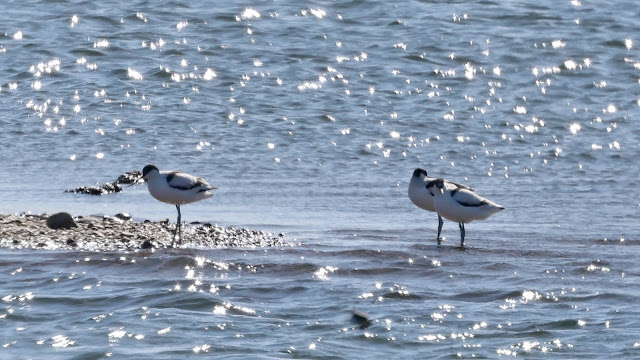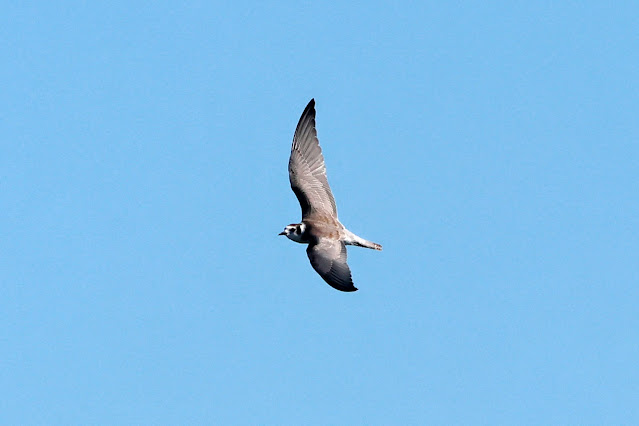A trip away in Kent and the chance to visit the RSPB reserve at Dungeness. Rather than go straight to the visitor centre I turned off and parked on the opposite side of the road and the ARC pit. There had been a Pectoral Sandpiper reported here through the week and I was hoping it was still about. The "Pec" as they are known has been few and far between in Hampshire so it was a great chance to reacquaint myself with this Nearctic wader.
Settling into the Hanson Hide there were a few Pochard snoozing in front of the hide.
I was in luck, the Pectoral Sandpiper was still present and showing on one of the islands in front of the hide. The light was bad and the island was not close but the images show the main features of this wader.
As was the neatly defined markings on the breast that give the bird its name.
It circumvented the island in the company of a Dunlin.
Then flew to another island amongst Mallard.
It then disappeared from view and I decided to make my way through the reserve to the visitor centre. Walking back to the car there were a lot of Migrant Hawker dragonflies in the scrub either side of the path. This was a male.
After checking in I made my way to the Dennis Hide, overlooking Burrow's Pit. Last week I stood for nearly five hours waiting for a White-winged Black Tern to show at Calshot. There has been a juvenile bird her for just under two weeks, once again I hoped it was still here. I had seen Black Terns from the visitor centre and as I settled into the hide, there were three Marsh Terns on an island in front of the hide. The two on the left were Black Terns but the tern on the right looked different.
The terns then took off and I followed one. Looking at the back of the camera I realised that I had been following the White-winged Black Tern.
White-winged Black Tern is a scarce visitor to Britain &
Ireland, with a handful of records every year, mostly between May and
September. Known as one of the “Marsh
Terns” of which there are three, White-winged, Black and Whiskered.
The breeding adult is wildly conspicuous in flight, with
contrasting black-and-white plumage; at rest note white shoulders contrasting
with black body. Non-breeding and younger birds are white with grey patches and
black “earmuffs.” In areas of overlap, the juvenile is told from Black Tern by
dark back contrasting with lighter upper wings and white rump and by black
marking above the shoulder. Non-breeding Whiskered Tern can be similar, but has
a faded, patchy dark crown instead of earmuffs.
I was lucky the tern kept coming close to the hide.
Once settled on the island a chance to compare the two terns. The White-winged is a little smaller and lighter in appearance, it also has smaller legs making it appear to be flat on the shingle.
Here a Black Tern in flight showing the smudge around the shoulder and side of the breast, and the dark wings.
A Great Egret flew past the hide.
A shot of the White-winged Black Tern showing the upper colours on the wings.
Three Avocet on one of the islands is a good record here apparently.
A better view of the White-winged on the island, showing the small legs.
Showing the clean white underneath.
I decided to leave the hide and walk around the reserve, there was still a cold wind but in sheltered spots it was warm in the sun and there were butterflies about.
A Common Blue.
A Common Darter on one of the many benches around the reserve.
These are set on one of the islands to attract Common Terns to nest.
A Marsh Harrier over the back of the reserve.
A smart, if damaged Peacock.
I had some time in the Denge Marsh Hide, I was taken by these Greylag Geese.
Outside the hide a female Migrant Hawker.
A spot identified as a Viewpoint had this view of the reserve and the distant power station.
Then another viewpoint looking out over the Denge Marsh.
As I was taking this photograph I heard the pinging calls of Bearded Tit and was then rewarded with these stunning views of a male close by.
I made my way back to the car park and then went into the Dennis Hide once more where the light was better for watching the terns.
Here four Black Terns.
Close up of one BlackTern.
The White-winged Black Tern was still about, here feeding over the water, picking out an insect. Like the other "marsh" terns, and unlike the
"white" terns, these birds do not dive for fish but fly slowly over
the water to surface-pick items and catch insects in flight. They mainly eat
insects and small fish. In flight, the wing-beats are shallow and leisurely.
In the light it could look similar to the White-winged, but the smudge on the shoulder is there to clinch the identification.
The White-winged Black Tern was now being easy to pick out amongst the Black Terns. Their breeding habitat is freshwater marshes across from
southeast Europe to Central Asia and the Russian Far
East. In winter, they migrate to Africa, southern Asia and Australia.
And a last look at the White-winged Black Tern, I have really enjoyed watching this smart little tern today, shame it wasn't Hampshire, but nice to catch up with. The last time I saw one was in 1991 at Tilbury Power Station in Essex.
I wanted one more go at the Pectoral Sandpiper as the light would be better. Just before reaching teh road I stopped for these three Cattle Egret.
That made all three egrets in the day which was nice.
The Pectoral Sandpiper was not showing on the islands. There had been working parties strimming the islands for the winter and this had flushed most of the birds. However it was nice to see a Glossy Ibis fly in.
Then settle nicely in view, showing well.
There was one wader in front of the hide, a Common Sandpiper.
A really enjoyable day with two quality year ticks.





































_MG_4943.jpg)























No comments:
Post a Comment